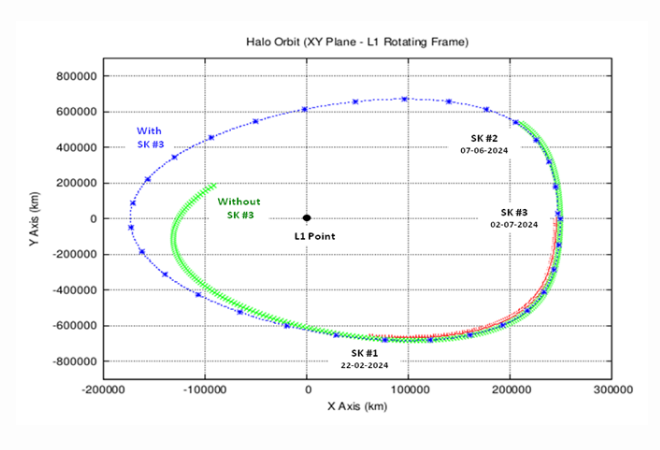In a remarkable achievement, the Aditya-L1 mission has successfully completed its first halo orbit around the Lagrangian point 1 (L1). This milestone marks a significant step forward in India’s space exploration program, demonstrating the country’s capabilities in navigating the complexities of space travel.
The Aditya-L1 spacecraft, India’s first solar mission, successfully completed its first halo orbit around the Sun-Earth L1 point, marking a significant milestone in space exploration. Launched by the Indian Space Research Organisation (ISRO) on September 2 last year, Aditya-L1 was inserted into its targeted halo orbit on January 6. ISRO expressed a lot of details about the solar observatory and its very first halo orbit. ISRO expressed that the Aditya-L1 mission is actually formulated to study the Sun. The observatory, as explained by ISRO, takes over 178 days in order to make one complete revolution around the L1 point.
Journey of Aditya-L1 :
Launching Date: September 2, 2023
Halo Orbit Settlement: January 6, 2024
Orbit Duration: 178 days per revolution
During the journey, Aditya-L1 encountered many problems. Right. He performed three space manoeuvres to remains calm. The last one occurred on July 2.2024, allowing it to continue in its second Halo orbit around the L1

ISRO has also released a diagram illustrating the spacecraft’s orbit. In the diagram, the orbit is shown as a blue trajectory on the X-Y plane. This image highlights the potential divergent path the spacecraft might have followed without precise manoeuvring.

Source : ISRO
The blue trajectory, in the figure, is the orbit around the Lagrangian point L1. This trajectory is a 3-dimensional trajectory, and what is shown is the projection of it in the X-Y plane. SK#1, 2 & 3 are the Station Keeping manoeuvres by the Aditya-L1 spacecraft. The final firing of the thrusters, i.e. SK#3 on July 2, placed the spacecraft back in the required orbit. If an accurate firing was not done, the spacecraft would have moved away in a trajectory shown in green colour. The X-Y axes are marked in distance of km, with Lagrangian point L1 at the origin.
The successful completion of the first halo orbit by Aditya-L1 demonstrates India’s technological prowess in space exploration. The mission will provide valuable insights into the Sun’s behaviour, space weather patterns, and the impact of solar activity on Earth’s magnetic field.
With this milestone achieved, the Aditya-L1 mission will continue to orbit the L1 point, collecting data and conducting experiments to further our understanding of the Sun and its effects on the solar system.
The Aditya-L1 mission’s completion of its first halo orbit is a testament to India’s growing capabilities in space exploration. As the mission continues to explore the Sun and its mysteries, it will undoubtedly make significant contributions to the field of astrophysics and space research.
